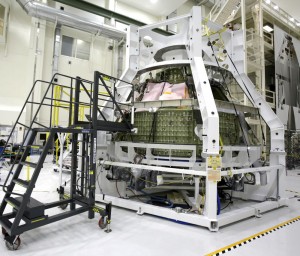US space agency plans to capture, explore asteroid

In this Jan. 13, 2013 file photo, the Orion Exploration Flight Test 1crew module is seen in the Operations and Checkout building during a media tour at the Kennedy Space Center in Cape Canaveral, Fla. Senate Science and Space subcommittee Chairman Sen. Bill Nelson, D-Fla. says President Barack Obama and NASA are planning for a robotic spaceship to lasso a small asteroid and park it near the moon. AP Photo
WASHINGTON— The U.S. space agency is planning for a robotic spaceship to capture a small asteroid and park it near the moon for astronauts to explore, a top senator disclosed Friday.
The plan would speed up by four years the existing mission to land astronauts on an asteroid by bringing the space rock closer to Earth, Sen. Bill Nelson said.
The robotic ship would capture the 500-ton, 25-foot (450 metric-ton, 7.6-meter) asteroid in 2019. Then using an Orion space capsule, now being developed, a crew of about four astronauts would nuzzle up next to the rock in 2021 for spacewalking exploration, according to a government document obtained by The Associated Press.
Nelson said this would help NASA develop the capability to nudge away a dangerous asteroid if one headed to Earth in the future. It also would be training for a future mission to send astronauts to Mars in the 2030s, he said.
Nelson, chairman of the Senate science and space subcommittee, said President Barack Obama is putting $100 million in planning money for the accelerated asteroid mission in the 2014 budget that comes out next week. The money would be used to find the right small asteroid.
Article continues after this advertisement“It really is a clever concept,” Nelson said in a news conference in Florida, the state where NASA launches take place. “Go find your ideal candidate for an asteroid. Go get it robotically and bring it back.”
Article continues after this advertisementWhile there are thousands of asteroids that size out there, finding the right one that comes by Earth at just the right time to be captured will not be easy, said Donald Yeomans, who heads NASA’s Near Earth Object program that monitors close-by asteroids. He said once a suitable rock is found, it would be captured with the space equivalent of “a baggie with a drawstring. You bag it. You attach the solar propulsion module to de-spin it and bring it back to where you want it.”
Yeomans said an asteroid of that size is no threat to Earth because it would burn up should it inadvertently enter Earth’s atmosphere. The mission as Nelson described is perfectly safe, he said.
The government document said the mission, with no price tag at the moment, would inspire because it “will send humans farther than they have ever been before.”